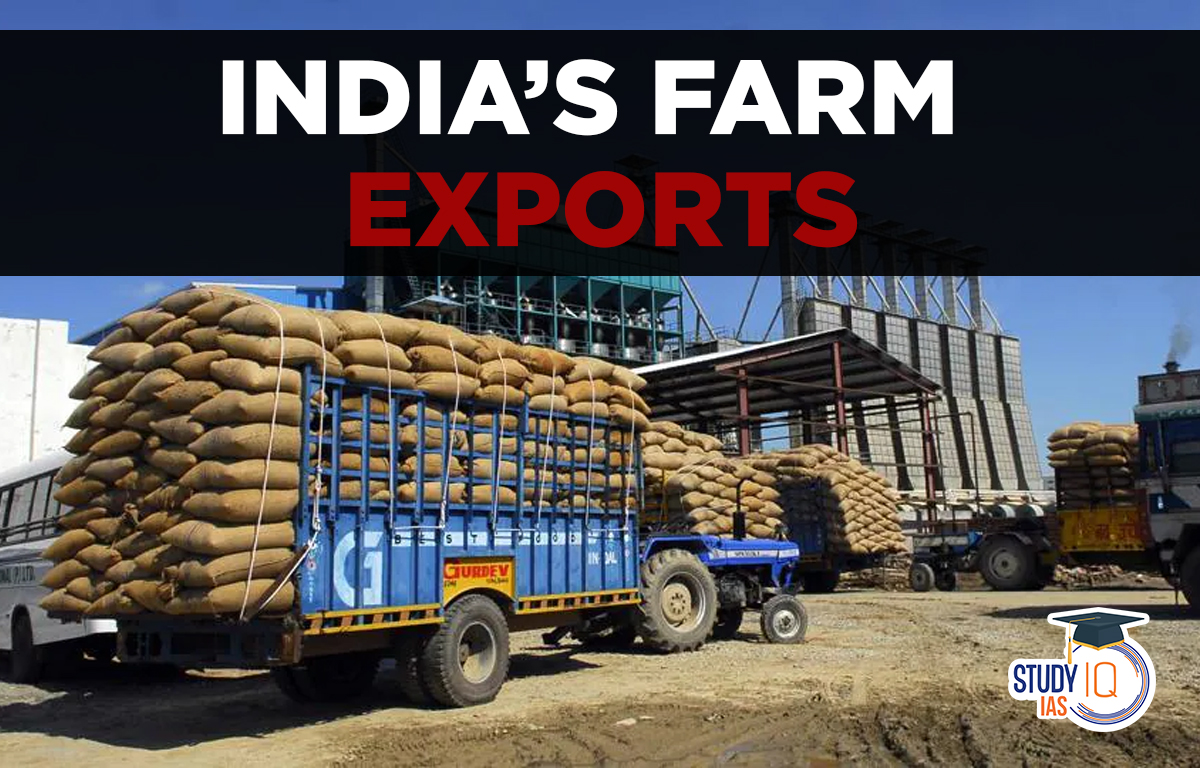Table of Contents
Context: India’s agricultural exports are on course to cross a new high but easing world prices may dampen the prospects.
Composition of India’s Agricultural Exports
- Rice: India is the world’s biggest rice exporter. It mainly exports top grade basmati rice to the Middle East and non-basmati rice to African and Asian countries.
- India in 2021-22 shipped out an all-time-high 21.21 million tonnes (mt) of rice including both non-basmati and basmati rice.
- In the current fiscal, the growth has been primarily led by basmati rice. Its exports have gone up by 40.3% in value and 16.6% in quantity terms. The corresponding increases have been less for non-basmati exports.
- Sugar: India is the world’s biggest producer of sugar and the second biggest exporter.
- India exports sugar to many Asian, African and Middle Eastern countries.
- Sugar exports hit a record $4.60 bn in 2021-22.
- Wheat: India is the world’s second-biggest producer of wheat.
- The exports of these big-ticket items have faltered or slowed due to poor crop and the ban on shipments imposed in May 2022.
- Buffalo meat: The value of buffalo meat shipments fell 5.1% from $2.51 billion in April-December 2021 to $2.39 billion in April-December 2022.

Composition of India’s Agricultural Imports
- Vegetable Oils: India meets around 60% of its domestic demand through imports.
- India imports palmolein from Indonesia, Malaysia and Thailand.
- Soybean oil comes from Argentina and Brazil, while sunflower oil comes from Ukraine and Russia.
- Cotton: India has been the largest producer of cotton globally.
- Bangladesh, China, and Vietnam were India’s major cotton importers in 2022.
- The exports of cotton collapsed and imports have soared. Thus, India has turned from a net exporter to a net importer of cotton.
- Cashew: India is among the largest cashew-producing countries in the world.
- India is the largest cashew exporter, with more than 15% of the world’s export share.
- The key export destinations for India are UAE, Japan, Netherland, Saudi Arabia, the USA, the UK, Canada, France, Israel, and Italy.
- Between Apr-Dec 2021 and April-December 2022, there has been a 64.6% rise of imports while exports of cashew products fell for the same period.
- Spices: India is the world’s largest spice producer. It is also the largest consumer and exporter of spices.
- The top export destinations are China, USA, Bangladesh, Thailand, the UAE, Sri Lanka, Malaysia, the UK, Indonesia, and Germany.
- Recently, the exports of spices have been de-growing and imports edging up.
Driving Factors for India’s Exports
- Effective Agriculture Export Policy: It aims to diversify our export basket, destinations and boost high value and value added agricultural exports including focus on perishables.
- It also strives to double India’s share in world agri exports by integrating with global value chain at the earliest.
- Support of Export Promotion Agencies including Export Inspection Council: The Export Inspection Council (EIC) is the official export –certification body of India which ensures quality and safety of products exported from India.
- EIC provides mandatory certification for fish & fishery products, dairy product, honey, egg products, meat and meat products, poultry meat products etc.
- Agricultural and Processed Food Products Export Development Authority (APEDA): It fixes standards and specifications for the scheduled products for the purpose of exports.
- Online issuance of certificates: They helped in growth of agricultural exports.
What Caused Fall in Exports?
- Ban on Shipments: India suspended the export of wheat and curbed the export of raw (white) and broken non-basmati rice in 2022.
- Decline in Cotton Production: While cotton production and productivity have not increased in India, cotton consumption has been rising.
- Cotton production has stagnated because of a lack of new seeds and modern irrigation facilities, and frequent pest attacks and diseases.
- One of the major reasons is also not allowing new GM technologies after the first-generation Bt cotton.
- Rise in Palmolein Imports: The main reason is the encouragement given by exporting countries (Malaysia and Indonesia) to their industry.
- They have kept high export duties on crude palm and low export duty on palmolein (finished product).
- Lack of Incentives for Cashew Industry: The withdrawal of export incentives under ‘Vishesh Krishi and Gram Udyog Yojana’ has impacted outbound shipments of cashew.
- There is also high cost of processing of cashews in India. It is four times more than that of Vietnam, which uses machines. In India, most of things are being done manually.
- Indian exporters are also facing tough competition from countries, including Guyana, Mozambique, Tanzania and Ivory Coast.
- Increased Competition in Spices: In Pepper, Vietnam, Brazil, and Indonesia have given fierce competition to India in terms of pricing.
- Russia is emerging as a new threat to India’s coriander exports because of the low pricing it offers compared to the Indian coriander.
- In Cardamom, Guatemala is the global leader in exports. Most of India’s exports go to the Middle East and Bangladesh, where Guatemala has a dominant foothold.
Way Forward
- A brand name for Indian cotton has been launched by the Union Government as “KASTURI COTTON INDIA” to attain the objective of making India Atmanirbhar and vocal for local in the field of cotton.
- The oils-and-cotton-driven growth in imports has important policy implications that need to be addressed.
- A proactive approach is also required in edible oils, where planting of GM hybrid mustard has been permitted with great reluctance.
- The focus of policymakers needs to shift from being pro-consumer (to the extent of banning/ restricting exports) to pro-producer (providing tariff protection against imports).


 Atlantic Meridional Overturning Circulat...
Atlantic Meridional Overturning Circulat...
 Data Protection Rules 2025: Key Features...
Data Protection Rules 2025: Key Features...
 Global TB Report 2025: India’s Progres...
Global TB Report 2025: India’s Progres...

























